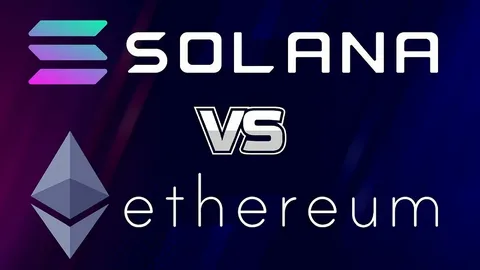Introduction
Over the past few years, Solana has gained significant attention for its lightning-fast transactions and low fees, positioning itself as a competitor to Ethereum. Billed as a “Ethereum killer” by some, Solana’s high throughput and unique Proof of History (PoH) mechanism set it apart during a time when Ethereum struggled with high gas fees and slower transaction speeds.
But the landscape is changing. Ethereum’s transition to Proof of Stake (PoS), its Layer-2 ecosystem, and its unwavering developer support have strengthened its position as the leading blockchain for decentralized applications (dApps). As Ethereum surges forward, developers and investors are beginning to notice cracks in Solana’s armor, prompting questions about the long-term sustainability of Solana’s “Golden Age.”
In this article, we’ll explore how Ethereum’s advancements and challenges within the Solana ecosystem are reshaping the narrative, potentially bringing Solana’s prime era to a conclusion.

1. Ethereum’s Persistent Developer Supremacy
A Magnet for Developers
Ethereum has been a dominant force in blockchain development since its inception in 2015. Its extensive tooling, robust programming language (Solidity), and thriving developer community have made it the go-to platform for building decentralized applications. For Ethereum developers, access to comprehensive documentation, active forums, and interoperable tools is a crucial advantage.
Solana, by contrast, has struggled to match Ethereum’s developer ecosystem. While its Rust programming language is powerful, it has a steeper learning curve for new developers, limiting its appeal to those entering the blockchain space. Ethereum’s emphasis on backward compatibility and continued investment in developer-centric improvements—such as the Ethereum Virtual Machine (EVM)—further cements its lead.
The Role of Layer-2 Solutions
Ethereum’s Layer-2 technologies, such as Arbitrum, Optimism, and zkSync, have revolutionized the scalability problem that once plagued the network. By dramatically reducing gas fees and increasing transaction throughput, Ethereum is now equipped to handle a wide range of dApps without compromising on security or decentralization.
In comparison, Solana’s monolithic approach, which focuses on scaling the base layer, has led to frequent network outages and stability concerns. Developers seeking reliability and consistent uptime are finding it increasingly difficult to overlook Ethereum’s expanding capabilities.
2. Solana’s Struggles with Decentralization and Stability
Centralization Concerns
One of the core tenets of blockchain technology is decentralization. While Solana boasts a high number of transactions per second (TPS), it achieves this at the expense of decentralization. A significant portion of Solana’s validator nodes are hosted on a few centralized cloud providers, raising concerns about the network’s resilience against censorship or attacks.
Ethereum, on the other hand, has made decentralization a priority. Its transition to Proof of Stake (PoS) has reduced energy consumption while maintaining a distributed network of validators. With over 800,000 validators globally, Ethereum is far less susceptible to centralization risks, making it a more attractive option for developers prioritizing security and long-term viability.
Network Outages
One of the most cited challenges facing Solana is its history of network outages. Since its launch, Solana has experienced multiple instances of downtime, often lasting hours and affecting users’ ability to transact or interact with dApps. These outages erode confidence in the network, particularly among developers building mission-critical applications.
In contrast, Ethereum’s emphasis on stability has paid off. The network has demonstrated remarkable resilience, even during periods of high traffic, such as during NFT and DeFi booms. For developers, this reliability is critical when choosing a blockchain to build upon.
3. The Growing Dominance of Ethereum’s Ecosystem
A Thriving dApp Ecosystem
Ethereum’s ecosystem is unparalleled, with thousands of dApps spanning DeFi, NFTs, gaming, and beyond. Platforms like Uniswap, OpenSea, and Aave have become household names in the blockchain space, driving massive user adoption and liquidity to Ethereum.
Solana, while home to innovative projects like Serum and Star Atlas, has struggled to match Ethereum’s breadth and depth of offerings. Many developers are wary of building on a platform where user adoption is limited compared to Ethereum’s massive audience.
Interoperability and Standards
Ethereum’s ERC-20, ERC-721, and other token standards have set the benchmark for blockchain interoperability. These standards enable seamless interaction between different dApps and tokens, fostering a cohesive and interconnected ecosystem. Solana lacks similar widespread standards, creating friction for developers aiming to integrate their projects with others.
Moreover, Ethereum’s Layer-2 rollups and cross-chain bridges are further enhancing interoperability, making it easier for developers to reach broader audiences without abandoning Ethereum’s robust infrastructure.
4. Investor Sentiment and Market Trends
Ethereum’s Decreasing Gas Fees
One of Solana’s initial appeals was its low transaction costs, which stood in stark contrast to Ethereum’s exorbitant gas fees during periods of congestion. However, with Ethereum’s transition to PoS and the rise of Layer-2 solutions, gas fees have significantly decreased, eroding one of Solana’s key advantages.
Institutional Adoption
Ethereum’s reputation as the first-mover in smart contract technology has made it the preferred choice for institutional investors. Companies like Visa and PayPal have integrated Ethereum-based solutions, further solidifying its dominance. While Solana has made strides in attracting institutional attention, its smaller ecosystem and technical vulnerabilities make it a less attractive option for large-scale investments.
Market Valuation
Ethereum’s market capitalization dwarfs that of Solana, underscoring its position as the industry leader. This market dominance allows Ethereum to attract more developers, investors, and users, creating a virtuous cycle of growth. As the gap widens, Solana’s Golden Age seems increasingly at risk of fading into history.
Conclusion
While Solana introduced innovative concepts that temporarily disrupted the blockchain landscape, Ethereum’s consistent advancements and steadfast developer community have ensured its dominance. From robust Layer-2 solutions to unmatched decentralization and a thriving ecosystem, Ethereum continues to set the standard for what a blockchain platform should be.
For developers and investors evaluating the future of blockchain technology, Ethereum’s advantages are becoming increasingly difficult to ignore. Meanwhile, Solana faces mounting challenges, from network stability issues to decentralization concerns, which threaten to bring its Golden Age to a conclusion.
Do you agree with this analysis, or do you think Solana still has untapped potential to reclaim its momentum? Share your thoughts in the comments below—we’d love to hear from you!






